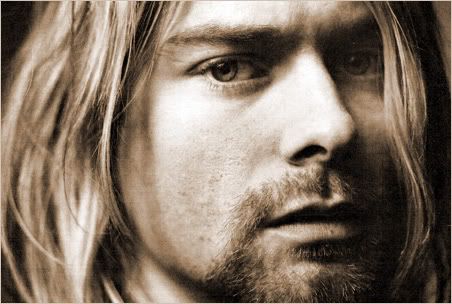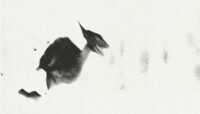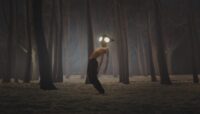KURT COBAIN: 1967-1994

“All Apologies”
from the album In Utero
1993
iTunes
The roots of grunge are varied and tangled, and they formed primarily in Seattle. But the emergence of Nirvana, and the stardom that came to singer-songwriter Kurt Cobain, happened in part via an assist from the New York-based post-punk band Sonic Youth.
Danny Goldberg, along with partner John Silva, managed Sonic Youth. Since the group’s members were always looking for new artists to join them on the road, they recommended Nirvana, which was seeking management.
Goldberg recalled seeing Nirvana play live for the first time at the Palace in Los Angeles shortly after his company signed the band in late 1990. “I was stunned how intimate the relationship was between Kurt and the audience, even with material that a lot of people didn’t know,” he said. “There was something about the way he performed that made him seem like a member of the audience and being on stage at the same time.”
In truth, if Goldberg and his partner hadn’t signed the band, Nirvana probably would have been huge anyway, because the word was out. Goldberg acknowledged that others were after the artists. Cobain and Nirvana had created a sound, a movement, a zeitgeist, that grabbed a generation by its lower flannel and wouldn’t let go until events caused it all to end.
One of those events occurred on April 8, 1994 — 15 years ago — when Cobain, 27, was found dead of a self-inflicted gunshot wound (the medical examiner would later estimate he died on the afternoon or evening of April 5.) Nirvana was no more. Because of the tragic ending, the legacies of Cobain and his band are usually linked in the collective memory with the depression that tormented the singer. Yet many in and around the “grunge” movement — and that term came later, after much music had been made and the outside world needed a label — recall that period with wistful joy.
“There were no rules,” said Chris Cornell, lead singer and guitarist for Soundgarden, one of the major acts that came out of the Seattle area around the same time as Nirvana, Pearl Jam and Alice in Chains, among others. “That was how the real alternative term started. It was supposed to mean anything that was an alternative to the popular mainstream.
“Seattle was a town where often larger acts wouldn’t come, but small indie acts that were traveling around in vans would go, because they would go anywhere. So we got everybody coming through.”
Cornell said it was that lack of attention and the focus on the art itself that led to a purity in the music of the time. “It was about isolation, a provincial isolation scenario,” said Cornell, who released Scream, his third solo album, earlier this year. “There was no big media, no dangling carrot of big media.
“We didn’t have stars in our eyes. We worked normal blue collar jobs to subsidize our music, to buy guitars, guitar strings, wah wah pedals. Nobody at that time came to Seattle to mine the unsigned bands. In the absence of the allure of success, there was a genuine outpouring of this musical inspiration. There were no distractions.”
‘Be authentic, don’t be formuliac’
Into that climate came Cobain, who grew up in Aberdeen, a logging and fishing town outside of Seattle, and “had a lot stacked against him before he ever picked up a guitar,” said Charles R. Cross, author of the definitive Cobain biography, “Heavier Than Heaven.” Cross had worked at a local music magazine in Seattle and was there during Nirvana’s rise.
“He came from a family where alcohol and depression were rampant,” Cross said. “In some ways I’m actually surprised he managed to make as much music as he did.”
Cross recalled a time shortly after Nirvana’s hit album Nevermind was recorded, but not yet released. “He got evicted from his place because he couldn’t pay $175 in rent,” he said. “After he recorded this album that would make him a star, there he was, sitting on the curb with all his stuff.”
The late 1980s weren’t considered a golden era of popular music. Hair bands had filled the landscape like herds of rock and roll Afghan hounds. Punk had long been dead, and serious music buffs were yearning for something new and meaningful.
“It was reflective of a musical shift,” Cross said of Nirvana and grunge in general. “Just prior to Nirvana going in to record Nevermind, one of my favorite stories is that the group that was in the studio recording right before them was Warrant, a heavy metal hair band.
“If there was a theme to grunge, it was be yourself, be authentic, don’t be formulaic. Nirvana, Soundgarden, Pearl Jam, Alice in Chains, in some instances you had ugly men making powerful music. What was important was the sound and not the look.”
Nirvana’s sound was largely crafted by Cobain, with great assistance from drummer Dave Grohl and bass player Krist Novoselic. “His singing style especially became the default template for rock music,” said Sasha Frere-Jones, pop music critic for The New Yorker magazine, of Cobain. “You could look at David Cook. Alice in Chains. Nickelback. He changed the way singing was done.”
Cobain’s songwriting was also helped to stir a generation. “Kurt Cobain was one of the most important writers in American rock history,” said Larry Mestel, CEO of Primary Wave Music Publishing, the company that owns the rights to Nirvana’s songs. “I think ‘Smells Like Teen Spirit’ was a song that changed the way people in the ’90s viewed music, everything from how unique the video was to the sound itself.”
‘All the bands were friends’
There was a period, around the late ’80s to early ’90s, when all was well, when the alternative bands that sprang from the Seattle area had started to develop a degree of commercial success, yet hadn’t yet been marketed to mass consumption. It was during that time that a feeling of camaraderie was as organic to the scene as worn jeans and work boots.
“It was a long, slow process,” Cornell explained. “It isn’t like you woke up one morning and there was Nirvana and Pearl Jam. It was a long, involved, incestuous process. One thing that ran true is that everybody was dedicated to making music. We all knew each other. We all had a friendly, healthy rivalry.
“Johnny Ramone made a comment to me once that the Seattle scene was the first scene he ever came across where all the bands were friends. In the New York punk scene he grew up in, everybody was a rival.”
Throughout the grunge phenomenon, Cobain was enigmatic and complex. “He was easy to get along with, other than when he was on drugs,” Goldberg said. “Then the darkness turned on him
self. On heroin he was zonked out and remote.
“In general, I found him to be very sweet and very smart. He was tormented, he had chronic stomach pains, he was prone to depression. But he had no struggles when it came to his music. He had absolute crystalline clarity when it came to everything about Nirvana, from the music to T-shirts to album covers. He made the final decisions on all the mixes. Personally, he was very nice to me and my family.”
A lot happened aside from Cobain’s death that signaled the end of grunge. Basically, it’s the old story in the entertainment business: Something starts out pure and good, it is discovered and exploited by those with dollar signs in their eyes, the product suffers, and what made it all special to begin with disappears.
“Living in L.A., I see how in the music scene a lot of people have trouble keeping bands together because members dart off whenever they see an opportunity,” Cornell said. “That eventually happened in Seattle. By the mid ’90s, it turned into the Sunset Strip. Musicians came from all over the world.
“A good friend of mine who ran a vintage or used guitar and musical equipment store said around 1998 he had so much equipment because people were leaving by that time and giving up the dream. It wasn’t what it used to be.”
‘It’s one of the hardest things I’ve had to deal with in my life’
Cobain’s suicide wasn’t the death knell for an entire movement, but it was the beginning of the end. He and his music meant a lot to a lot of people, and when he took his own life, he effectively replaced hope with melancholy.
“It seems remarkable that it’s been 15 years,” Cross said. “I was one of the first people to hear he was dead before the public found out. The guy who found his body called a radio station, and they called me. I remember picking up the phone, getting the message and being in absolute shock, wanting to deny it.”
When he looks back on it today, Cornell, the Soundgarden frontman who shared the same musical growing pains as his grunge brethren, still feels the hurt of losing Cobain.
“That’s been one of the most difficult things I’ve had to deal with in my life,” he said. “Kurt, as well as several other people who had so much promise and talent, who made me look forward to the future of music and the art form, the limitless music they would create, and then to have all those possibilities completely disappear in front of you. No re-releases or revamping or newly discovered masters can ever take the place of a newly created song or a perspective of somebody who would have been in his forties.
“It’s one of the hardest things I’ve had to deal with in my life.”
But before the label was put on the genre, before Nirvana became a band for the ages — “I think this is one of the few cases where you couldn’t overestimate how important it was,” The New Yorker’s Frere-Jones said — there was the music that doused the flames of hair-band hell and reminded people what rock was all about.
Mary Cellini managed a record store at La Brea and Sunset in Los Angeles. She was dating a guy at the time who booked acts at a club called Raji’s, which is no longer around but had been a hotspot for punk and alternative bands. She was introduced to Cobain and his girlfriend/wife Courtney Love through her boyfriend.
She remembered one night at another club, The Roxy, in which Nirvana had the crowd in, well, nirvana.
“I’m not doubting or lessening the fact that Cobain had his personal demons,” she said. “I’m just saying there was a whole other side to him and his music that was funny and positive.
“One Nirvana show sticks out in my memory as being one of the best live music nights of my life. It was at the Roxy right as their album Nevermind was being released. From the first guitar strum we and the rest of the audience were in heaven. Everyone was moving in unison in a bubble of total joy and excitement. Our favorite moment was spotting a family pogo-ing together arm in arm. There was a father, mother and two kids just bouncing to the music with the biggest smiles on their faces, at the center of the mosh pit.
“I view Cobain and his music as a gift. There have been many times over the years when I have been down or sad and in many of those moments I have often thought of that night and smiled.”


